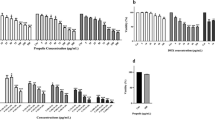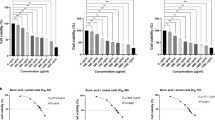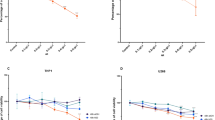Abstract
Background
Britannin, a Sesquiterpene Lactone isolated from Inula aucheriana, has recently gained attraction in the therapeutic fields due to its anti-tumor properties. This study was designed to evaluate the effect of this agent on Acute Lymphoblastic Leukemia (ALL) cell lines, either as a monotherapy or in combination with Vincristine (VCR).
Methods and Results
To determine the anti-leukemic effects of Britannin on ALL-derived cell lines and suggest a mechanism of action for the agent, we used MTT assay, Annexin-V/PI staining, ROS assay, and real-time PCR analysis. Moreover, by using a combination index (CI), we evaluated the synergistic effect of Britannin on Vincristine. We found that unlike normal Peripheral Blood Mononuclear Cells (PBMCs) and L929 cells, Britannin reduced the viability of NALM-6, REH, and JURKAT cells. Among tested cells, NALM-6 cells had the highest sensitivity to Britannin, and this agent was able to induce p21/p27-mediated G1 cell cycle arrest and Reactive Oxygen Specious (ROS)-mediated apoptotic cell death in this cell line. When NALM-6 cells were treated with Nacetyl-L-Cysteine (NAC), a scavenger of ROS, Britannin could induce neither apoptosis nor reduce the survival of the cells suggesting that the cytotoxic effect of Britannin is induced through ROS-dependent manner. Moreover, we found that a low dose of Britannin enhanced the effect of Vincristine in NALM-6 cells by inducing apoptotic cell death via altering the expression of apoptotic-related genes.
Conclusions
Overall, our results proposed a mechanism for the cytotoxic effect of Britannin, either as a single agent or in combination with Vincristine, in NALM-6 cells.




Similar content being viewed by others
References
Pui CH, Nichols KE, Yang JJ (2019) Somatic and germline genomics in paediatric acute lymphoblastic leukaemia. Nat Rev Clin Oncol 16(4):227–240
Pui CH et al (2015) Childhood acute lymphoblastic leukemia: progress through collaboration. J Clin Oncol 33(27):2938–2948
Terwilliger T, Abdul-Hay M (2017) Acute lymphoblastic leukemia: a comprehensive review and 2017 update. Blood Cancer J 7(6):e577–e577
Iacobucci I, Mullighan CG (2017) Genetic basis of acute lymphoblastic leukemia. J Clin Oncol 35(9):975–983
Pui CH et al (2009) Treating childhood acute lymphoblastic leukemia without cranial irradiation. N Engl J Med 360(26):2730–2741
Raetz EA et al (2008) Reinduction platform for children with first marrow relapse of acute lymphoblastic Leukemia: A Children’s Oncology Group Study[corrected]. J Clin Oncol 26(24):3971–3978
Brower V (2008) Back to nature: extinction of medicinal plants threatens drug discovery. Oxford University Press, Oxford
Yami A et al (2020) Ergolide, a potent sesquiterpene lactone induces cell cycle arrest along with ROS-dependent apoptosis and potentiates vincristine cytotoxicity in ALL cell lines. J Ethnopharmacol 253:112504
Moghadam MH et al (2012) Anti-proliferative activity and apoptotic potential of britannin, a sesquiterpene lactone from Inula aucheriana. Nat Prod Commun 7(8):1934578 × 1200700804
Chugunov P et al (1971) The structure of britannin—a sesquiterpene lactone from Inula britannica. Chem Nat Compd 7(3):265–268
Bown D (2002) The royal horticultural society. New encyclopedia of herbs and their uses. Dorling Kindersley Limited. Penguin Company, London
Seca AM et al (2014) The genus Inula and their metabolites: from ethnopharmacological to medicinal uses. J Ethnopharmacol 154(2):286–310
Moeinifard M et al (2017) Britannin induces apoptosis through AKT-FOXO1 pathway in human pancreatic cancer cells. Biomed Pharmacother 94:1101–1110
Zhang YF et al (2020) Britannin stabilizes T cell activity and inhibits proliferation and angiogenesis by targeting PD-L1 via abrogation of the crosstalk between Myc and HIF-1α in cancer. Phytomedicine 81:153425
Fallahian F, Hamzeloo-Moghadam M, Mahmoud MH, Aghaei (2015) Induction of apoptosis in human breast cancer cells by Britannin, a sesquiterpene lactone from Inula aucheriana
Cui Y-Q, Liu Y-J, Zhang F (2018) The suppressive effects of britannin (Bri) on human liver cancer through inducing apoptosis and autophagy via AMPK activation regulated by ROS. Biochem Biophys Res Commun 497(3):916–923
Safaroghli-Azar A et al (2017) PI3K-δ inhibition using CAL-101 exerts apoptotic effects and increases doxorubicin-induced cell death in pre-B-acute lymphoblastic leukemia cells. Anti-cancer drugs 28(4):436–445
Wang Q et al (2017) Luteolin induces apoptosis by ROS/ER stress and mitochondrial dysfunction in gliomablastoma. Cancer Chemother Pharmacol 79(5):1031–1041
Mondal J, Panigrahi AK, Khuda-Bukhsh AR (2014) Anticancer potential of Conium maculatum extract against cancer cells in vitro: drug-DNA interaction and its ability to induce apoptosis through ROS generation. Pharmacogn Mag 10(Suppl 3):S524
Koehn FE, Carter GT (2005) The evolving role of natural products in drug discovery. Nat Rev Drug Discov 4(3):206–220
O’Donovan TR, O’Sullivan GC, McKenna SL (2011) Induction of autophagy by drug-resistant esophageal cancer cells promotes their survival and recovery following treatment with chemotherapeutics. Autophagy 7(5):509–524
Xu R et al (2018) The clinical value of using chloroquine or hydroxychloroquine as autophagy inhibitors in the treatment of cancers: a systematic review and meta-analysisemclose. Medicine 97(46):12912
Waanders E et al (2020) Mutational landscape and patterns of clonal evolution in relapsed pediatric acute lymphoblastic leukemia. Blood Cancer Discov 1(1):96
Nguyen K et al (2008) Factors influencing survival after relapse from acute lymphoblastic leukemia: a Children’s Oncology Group study. Leukemia 22(12):2142–2150
Hamzeloo-Moghadam M et al (2015) Britannin, a sesquiterpene lactone, inhibits proliferation and induces apoptosis through the mitochondrial signaling pathway in human breast cancer cells. Tumor Biol 36(2):1191–1198
Coqueret O (2003) New roles for p21 and p27 cell-cycle inhibitors: a function for each cell compartment? Trends Cell Biol 13(2):65–70
Mohammadlou H et al (2021) Britannin a sesquiterpene lactone from inula aucheriana exerted an anti-leukemic effect in acute lymphoblastic leukemia (ALL) cells and enhanced the sensitivity of the cells to vincristine. Nutr Cancer. https://doi.org/10.1080/01635581.2021.1931700
Hamzeloo-Moghadam M et al (2019) Anticancer activity of britannin through the downregulation of cyclin D1 and CDK4 in human breast cancer cells. J Cancer Res Ther 15(5):1105
Tapon N et al (2002) salvador Promotes both cell cycle exit and apoptosis in Drosophila and is mutated in human cancer cell lines. Cell 110(4):467–478
Khan M et al (2016) Killing cancer with platycodin D through multiple mechanisms. J Cell Mol Med 20(3):389–402
Ruefli AA et al (2001) The histone deacetylase inhibitor and chemotherapeutic agent suberoylanilide hydroxamic acid (SAHA) induces a cell-death pathway characterized by cleavage of Bid and production of reactive oxygen species. Proc Natl Acad Sci USA 98(19):10833–10838
Cho H-D et al (2018) Auriculasin-induced ROS causes prostate cancer cell death via induction of apoptosis. Food Chem Toxicol 111:660–669
Chang H, Zou Z (2020) Targeting autophagy to overcome drug resistance: further developments. J Hematol Oncol 13(1):1–18
Rubinstein AD, Kimchi A (2012) Life in the balance–a mechanistic view of the crosstalk between autophagy and apoptosis. J Cell Sci 125(22):5259–5268
Acknowledgements
The authors would like to express their gratitude to Shahid Beheshti University of Medical Sciences (Tehran, Iran) for supporting this study and Dr. Aliakbar Mohammadlou, a Postdoctoral researcher at Boston College, who helped with editing the manuscript.
Funding
This study was supported by a fund of Laboratory Hematology and Blood Bank Department, School of Allied Medical Science, Shahid Beheshti University of Medical Sciences, Tehran, Iran.
Author information
Authors and Affiliations
Contributions
HM carried out the experiments and drafted the manuscript; MH-M collected I. aucheriana, prepared, isolated, and purified the compound; MHM was involved in supervising the project; AY designed the primers; AG conceived the study, designed and coordinated it, and finalized the manuscript. All authors gave final approval for publication.
Corresponding author
Ethics declarations
Conflict of interest
The authors declare that they have no conflict of interest.
Research involving human and animal participants
This article does not contain any studies with human participants or animals performed by any of the authors.
Additional information
Publisher’s Note
Springer Nature remains neutral with regard to jurisdictional claims in published maps and institutional affiliations.
Rights and permissions
About this article
Cite this article
Mohammadlou, H., Hamzeloo-Moghadam, M., Mohammadi, M.H. et al. Britannin, a sesquiterpene lactone induces ROS-dependent apoptosis in NALM-6, REH, and JURKAT cell lines and produces a synergistic effect with vincristine. Mol Biol Rep 48, 6249–6258 (2021). https://doi.org/10.1007/s11033-021-06572-x
Received:
Accepted:
Published:
Issue Date:
DOI: https://doi.org/10.1007/s11033-021-06572-x




